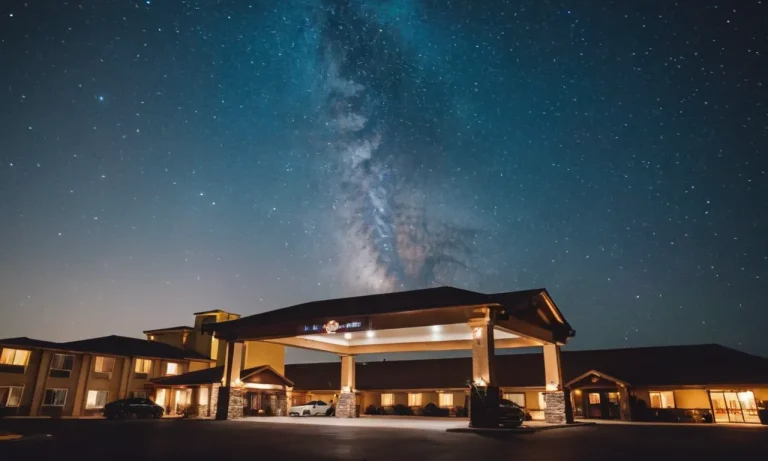How Much Land Is Needed For A Hotel? A Comprehensive Guide
Embarking on a hotel development project is an exciting yet daunting endeavor. One of the most crucial factors to consider is the amount of land required to accommodate your vision. Whether you’re planning a boutique hotel or a sprawling resort, understanding the land requirements is essential for a successful and profitable venture.
If you’re short on time, here’s a quick answer to your question: The amount of land needed for a hotel varies greatly depending on factors such as the hotel’s size, number of rooms, amenities, parking requirements, and local zoning regulations.
Generally, a small hotel with 50-100 rooms may require 1-2 acres, while a larger hotel with 200-300 rooms could need 5-10 acres or more.
In this comprehensive guide, we’ll delve into the intricacies of land requirements for hotels, exploring the various factors that influence the decision-making process. From understanding zoning regulations to calculating parking needs, we’ll provide you with the knowledge and insights necessary to make informed decisions about your hotel project.
Zoning Regulations and Local Requirements
When planning to build a hotel, it’s crucial to understand and comply with local zoning laws and regulations. These rules govern the types of structures that can be built in specific areas and ensure that new developments align with the community’s vision and priorities.
Failing to adhere to these regulations can result in costly fines, delays, or even project cancellation.
Understanding Local Zoning Laws
Zoning laws vary from one municipality to another, so it’s essential to research the specific requirements for the area where you intend to build your hotel. These laws typically outline the permitted uses for different zones, such as residential, commercial, or mixed-use.
They may also specify the maximum density, building height, and setback requirements. Consulting with local zoning officials and reviewing the zoning code is crucial to ensure your hotel project complies with all applicable regulations.
Setback Requirements
Setback regulations dictate the minimum distance a building must be set back from property lines, streets, and other structures. These requirements aim to maintain adequate space between buildings and ensure proper access for emergency vehicles.
Setback distances can vary based on the zoning district, building height, and intended use. According to Nolo.com, typical setback requirements range from 10 to 25 feet from the front property line and 5 to 15 feet from side and rear property lines.
Height Restrictions
Many municipalities impose height restrictions on buildings to maintain a cohesive skyline, preserve views, or prevent overcrowding. These restrictions can vary based on the zoning district and may be influenced by factors such as proximity to airports or historic districts.
Exceeding height limits can result in significant penalties, so it’s crucial to thoroughly understand and comply with these regulations when planning your hotel’s design and construction.
Parking Regulations
Adequate parking is a critical consideration for hotels, as guests and staff will need a place to park their vehicles. Local zoning codes typically specify the minimum number of parking spaces required based on the hotel’s size, number of rooms, and proximity to public transportation.
Some areas may also have requirements for accessible parking spaces, electric vehicle charging stations, or bicycle parking facilities. Failure to provide sufficient parking can lead to fines, negative reviews, and dissatisfied guests, so it’s essential to carefully plan and allocate space for parking in your hotel project.
By thoroughly understanding and adhering to local zoning regulations and requirements, you can ensure a smoother and more successful hotel development process. Consulting with local authorities, hiring experienced professionals, and staying up-to-date with any changes in regulations can help mitigate potential issues and ensure your hotel project meets all necessary standards and requirements.
Hotel Size and Room Count
When it comes to planning a hotel, one of the most crucial factors to consider is the size and room count. The number of rooms directly impacts the amount of land required, construction costs, staffing needs, and overall operational expenses.
In this section, we’ll explore the different hotel sizes and provide insights on calculating room density.
Small Hotels (50-100 Rooms)
Small hotels, typically ranging from 50 to 100 rooms, are often found in urban areas or tourist destinations where space is limited. These intimate properties cater to travelers seeking a cozy and personalized experience.
According to Hotel News Resource, small hotels require approximately 0.5 to 1.5 acres of land, depending on the amenities offered and local zoning regulations.
Mid-Size Hotels (100-200 Rooms)
Mid-size hotels, with room counts between 100 and 200, strike a balance between intimacy and scale. These properties often feature a range of amenities, such as restaurants, meeting spaces, and recreational facilities.
Based on industry data from HospitalityNet, mid-size hotels typically require 2 to 4 acres of land to accommodate the guest rooms, public spaces, and parking areas.
Large Hotels (200+ Rooms)
Large hotels, with 200 or more rooms, are typically found in major cities, resort destinations, or near major attractions. These properties cater to a diverse range of travelers, including leisure guests, business travelers, and convention attendees.
According to Hotel Online, large hotels can require anywhere from 5 to 20 acres of land, depending on the number of rooms, amenities, and additional facilities like convention centers or golf courses.
Calculating Room Density
Room density is a crucial metric used in hotel planning and design. It refers to the number of rooms per acre of land. Generally, the higher the room density, the more efficient the use of land. However, higher densities can also lead to increased construction costs and potentially diminished guest experience due to crowding.
According to industry experts, a typical room density ranges from 30 to 60 rooms per acre for mid-size and large hotels, while small hotels may have a higher density of up to 100 rooms per acre. Factors such as local zoning regulations, site topography, and desired amenities can significantly impact the optimal room density for a particular hotel project.
It’s worth noting that these figures are approximate and can vary based on location, market conditions, and specific project requirements. Consulting with experienced hotel developers, architects, and local authorities is essential to ensure accurate land calculations and compliance with zoning regulations.
After all, having the right amount of land is crucial for creating a successful and well-designed hotel that meets the needs of guests and maximizes returns for investors.
Amenities and Facilities
When it comes to designing a hotel, the amenities and facilities are crucial elements that can significantly impact the guest experience and the overall success of the property. These features not only provide convenience and comfort to guests but also serve as a competitive advantage in the hospitality industry.
Restaurants and Dining Areas
Restaurants and dining areas are essential components of any hotel. They offer guests a convenient and enjoyable dining experience without having to leave the premises. According to a survey by Cvent, 73% of hotel guests consider on-site dining options as an important factor when choosing a hotel.
Hotels typically allocate space for a main restaurant, a bar or lounge area, and sometimes additional specialty dining options. The size and layout of these spaces depend on the hotel’s capacity and target market.
Conference and Meeting Spaces
For hotels catering to business travelers and corporate events, conference and meeting spaces are a must-have. These facilities can range from small boardrooms to large ballrooms, depending on the hotel’s target clientele.
According to Statista, the global hotel meeting space revenue was estimated at $13.6 billion in 2019. 😮 Well-designed and equipped conference spaces can attract corporate clients and generate additional revenue streams for the hotel.
Recreational Facilities (Pools, Spas, Fitness Centers)
Recreational facilities such as pools, spas, and fitness centers have become increasingly important for hotels, especially those catering to leisure travelers. These amenities provide guests with opportunities for relaxation, rejuvenation, and maintaining their fitness routines while on vacation.
According to a study by Hotel News Resource, 89% of hotel guests consider a fitness center as an important factor when choosing a hotel. 💪 Hotels often allocate significant space for these facilities, ensuring they are well-equipped and visually appealing.
Outdoor Spaces and Landscaping
Outdoor spaces and landscaping play a vital role in creating a welcoming and aesthetically pleasing environment for guests. These areas can include gardens, courtyards, terraces, and outdoor seating areas.
Well-designed outdoor spaces not only enhance the overall ambiance of the hotel but also provide guests with opportunities for relaxation and socializing. According to Travel Weekly, hotels are increasingly investing in outdoor spaces to cater to guests’ desires for fresh air and natural surroundings.
🌳🌺
When determining the amount of land needed for a hotel, it’s essential to consider the desired amenities and facilities, as they can significantly impact the overall footprint and layout of the property.
By carefully planning and allocating space for these features, hotels can create a comprehensive and exceptional guest experience that sets them apart from the competition.
Parking and Transportation Considerations
When planning a hotel, ensuring adequate parking and transportation facilities is crucial for guest convenience and accessibility. Proper planning in this area can make or break the overall experience, so it’s essential to get it right from the start.
Guest Parking Requirements
One of the primary considerations is providing sufficient parking spaces for guests. According to the Hotel News Resource, the industry standard for guest parking is typically 0.7 to 1.2 spaces per room. However, this can vary based on the hotel’s location, target market, and amenities.
For instance, urban hotels may require fewer spaces due to the availability of public transportation, while resorts or hotels catering to business travelers may need more spaces to accommodate guests with rental cars or multiple vehicles.
Employee Parking Needs
In addition to guest parking, hotels must also account for employee parking. The Hotel News Resource suggests allocating 0.3 to 0.5 spaces per employee, depending on the hotel’s size and staffing levels.
Employee parking should be separate from guest parking to ensure a smooth flow of traffic and minimize congestion.
Valet and Drop-Off Areas
Many hotels, especially luxury properties, offer valet services to enhance the guest experience. In such cases, a dedicated valet area with ample space for vehicle staging and guest drop-off/pick-up is essential.
According to Hospitality Net, the recommended area for valet operations is approximately 1,200 square feet for every 100 rooms. This space should be designed with efficient traffic flow and guest safety in mind.
Accessibility and Public Transportation
In today’s eco-conscious world, hotels should also consider accessibility to public transportation. By providing easy access to buses, trains, or other modes of transportation, hotels can cater to guests who prefer not to drive or wish to reduce their carbon footprint.
According to a study by the American Hotel & Lodging Association, 👍 61% of travelers consider a hotel’s proximity to public transportation when making booking decisions.
Moreover, hotels must comply with the Americans with Disabilities Act (ADA) guidelines, which mandate accessible parking spaces, ramps, and pathways for guests with disabilities. By incorporating these features, hotels not only ensure compliance but also provide an inclusive and welcoming environment for all guests.
Remember, parking and transportation considerations are not just about meeting minimum requirements – they’re about creating a seamless and enjoyable experience for guests from the moment they arrive until they depart.
Conclusion
Determining the appropriate amount of land for a hotel project is a multifaceted process that requires careful consideration of various factors. From adhering to local zoning regulations and accommodating the desired room count to incorporating essential amenities and addressing parking needs, each aspect plays a crucial role in ensuring the success of your hotel development.
By thoroughly evaluating your project’s requirements and consulting with experienced professionals, you can make informed decisions about the land acquisition process. Remember, investing in the right amount of land not only ensures compliance with regulations but also provides the necessary space for your hotel to thrive and offer an exceptional guest experience.
Whether you’re embarking on a small boutique hotel or a grand resort, this comprehensive guide has equipped you with the knowledge and insights to navigate the complexities of land requirements for hotels.
With careful planning and a strategic approach, you can create a hotel that not only meets but exceeds the expectations of your guests, while maximizing your investment and ensuring long-term profitability.







